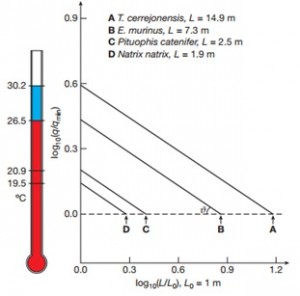“A lost world of giants, 60 million years old…
Ruled by a reptile of unbelievable size, it sounds like fantasy, but it’s not.
This world was once here…
Dominated by the most terrifying predator…
This is Titanoboa.”

As climate scientists, we are always very excited to deepen our knowledge of future climate. But looking backwards in time can also be fascinating, especially if the story involves the most powerful, largest, gigantic monstrous snake.
In 2009, Jonathan Bloch and his team led a scientific expedition in Colombia and discovered the fossils of Titanoboa in the coal mines of Cerrejón in La Guajira.[i] This discovery was exciting but once they had found out it was a giant snake, the fun really began. First of all, here are some interesting facts about reptiles which we should know.

Reptiles have indeterminate growth.[ii] In other words they can keep on growing slowly after adulthood. Also, snakes are heterothermic reptiles, which means that any excess of warm air becomes an invitation to promote a higher metabolism, implying it can allow much more on its plate. This reveals that the titanoboa must have been living in an environment which had access to more resources. So as a conclusion, the snake could grow larger in a warm environment. From these two points, it clearly indicates that large body size in Titanoboa provides significant information on equatorial climates during the Palaeogene.
Thus this discovery did not only contribute to the zoology field, but also in the climate field. Researchers could use this massive prehistoric snake as a paleothermometer to obtain an estimate of the temperature in South America during the Palaeocene epoch, a 10 million-year period following the extinction of the dinosaurs.

So let’s work out the calibration of this thermometer.
The current temperature in South America (Mean Annual Temperature (MAT) 26.5’C) restricts the modern Anaconda to grow to a specific maximum size (7.3m). We can also compare the Titanoboa to 2 other modern boid snakes, Pituophis catenifer (L = 2.5 m) and the Natrix natri (L = 1.9 m). Recent studies suggest that mass-specific metabolic rate q (energy spent per unit body mass per unit time), declines with increasing body mass M but grows with increasing ambient temperature T.[iii]
q (M, T)= q0 (M/M0)-xQ10(T-T0)/10’C
q0 is the value at a reference body mass M0.
TemperatureT0, Q10 and x (the metabolic scaling exponent) are constants.
Thus any species which lives in warm environment will adopt a large maximum body size. By plotting a log-log scale of the metabolic rates (q) of the 3 modern snakes living at different temperatures against the body length (L is proportional to M1/3), we can work out the estimated metabolic rate of the titanoboa and the ambient temperature T using an estimated body size length (10.4-14.9m) of the titanoboa from the fossil. [iv]

Figure 1| A graph of the log-log scale of the metabolic rates (q) of the 4 snakes living at different temperatures against the body length [v]
Figure 1 shows the allometric dependencies of mass specific metabolic rate q on body length L are at four different temperatures. The points at which the allometric lines cross the horizontal dashed-line q = qmin correspond to body lengths of the largest snakes in Palaeocene neotropics (A), South America (B), Colorado (C) and the United Kingdom (D). Using this approach, we can thus expect an estimate of the ambient temperature of 30.2’C in South America during the paleocene. This is even warmer than the current average equatorial temperature of 18’C. Since this estimate is above 30’C it also suggests that the chemicals necessary for photosynthesis were probably not working (more likely a desert?). Clearly the titanoboa fossil has much more insights which can be interpreted and revealed. In fact this information could prove to be highly useful in the modelling of future climate.
[i] Head, J. J. et al.Giant boid snake from the Palaeocene neotropics reveals hotter past
equatorial temperatures. Nature 457, 715–717 (2009)
[ii] Makarieva, A. M., Gorshkov, V. G. & Li, B.-L. Gigantism, temperature and metabolic
rate in terrestrial poikilotherms. Proc. R. Soc. Lond. B 272, 2325–2328 (2005).
[iii] Makarieva, A. M., Gorshkov, V. G. & Li, B.-L. Temperature-associated upper limits to
body size in terrestrial poikilotherms. Oikos111, 425–436 (2005).
Gorshkov, V. G. The distribution of energy flow among the organisms of different
dimensions. Zh. Obshch. Biol. 42, 417–429 (1981).
[iv] Makarieva, A. M., Gorshkov, V. G. & Li, B.-L. A note on metabolic rate dependence on
body size in plants and animals. J. Theor. Biol. 221, 301–307 (2003).
[v] J. J. Head et al. Re-callibrating the snake thermometer Nature 457, 715–717 (2009)

Sheveenah Sunnassee Taukoor
@Stefaan
Hahahaha this made me laugh. But hey, expect the comeback of Mr Titanoboa! Forget snakes, think of giant frogs, giant crocs, it might be fun.
Stefaan
So if global warming gets out of control we’ll have to deal with 15m long snakes?
Sheveenah Sunnassee Taukoor
https://www.youtube.com/watch?v=gVMCuZZ3XKk
Battle of T-rex and Titanoboa